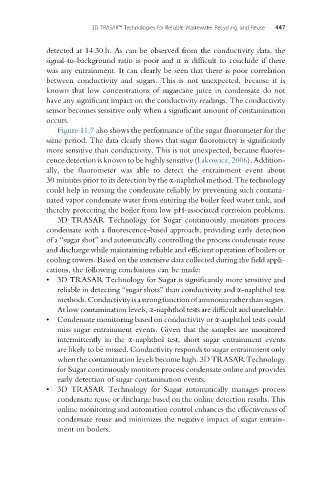Page 477 - Industrial Wastewater Treatment, Recycling and Reuse
P. 477
3D TRASAR™ Technologies for Reliable Wastewater Recycling, and Reuse 447
detected at 14:30 h. As can be observed from the conductivity data, the
signal-to-background ratio is poor and it is difficult to conclude if there
was any entrainment. It can clearly be seen that there is poor correlation
between conductivity and sugars. This is not unexpected, because it is
known that low concentrations of sugarcane juice in condensate do not
have any significant impact on the conductivity readings. The conductivity
sensor becomes sensitive only when a significant amount of contamination
occurs.
Figure 11.7 also shows the performance of the sugar fluorometer for the
same period. The data clearly shows that sugar fluorometry is significantly
more sensitive than conductivity. This is not unexpected, because fluores-
cence detection is known to be highly sensitive (Lakowicz, 2006). Addition-
ally, the fluorometer was able to detect the entrainment event about
30 minutes prior to its detection by the a-naphthol method. The technology
could help in reusing the condensate reliably by preventing such contami-
nated vapor condensate water from entering the boiler feed water tank, and
thereby protecting the boiler from low pH-associated corrosion problems.
3D TRASAR Technology for Sugar continuously monitors process
condensate with a fluorescence-based approach, providing early detection
of a “sugar shot” and automatically controlling the process condensate reuse
and discharge while maintaining reliable and efficient operation of boilers or
cooling towers. Based on the extensive data collected during the field appli-
cations, the following conclusions can be made:
• 3D TRASAR Technology for Sugar is significantly more sensitive and
reliable in detecting “sugar shots” than conductivity and a-naphthol test
methods.Conductivityisastrongfunctionofammoniaratherthansugars.
At low contamination levels, a-naphthol tests are difficult and unreliable.
• Condensate monitoring based on conductivity or a-naphthol tests could
miss sugar entrainment events. Given that the samples are monitored
intermittently in the a-naphthol test, short sugar entrainment events
are likely to be missed. Conductivity responds to sugar entrainment only
when the contamination levels become high. 3D TRASAR Technology
for Sugar continuously monitors process condensate online and provides
early detection of sugar contamination events.
• 3D TRASAR Technology for Sugar automatically manages process
condensate reuse or discharge based on the online detection results. This
online monitoring and automation control enhances the effectiveness of
condensate reuse and minimizes the negative impact of sugar entrain-
ment on boilers.

